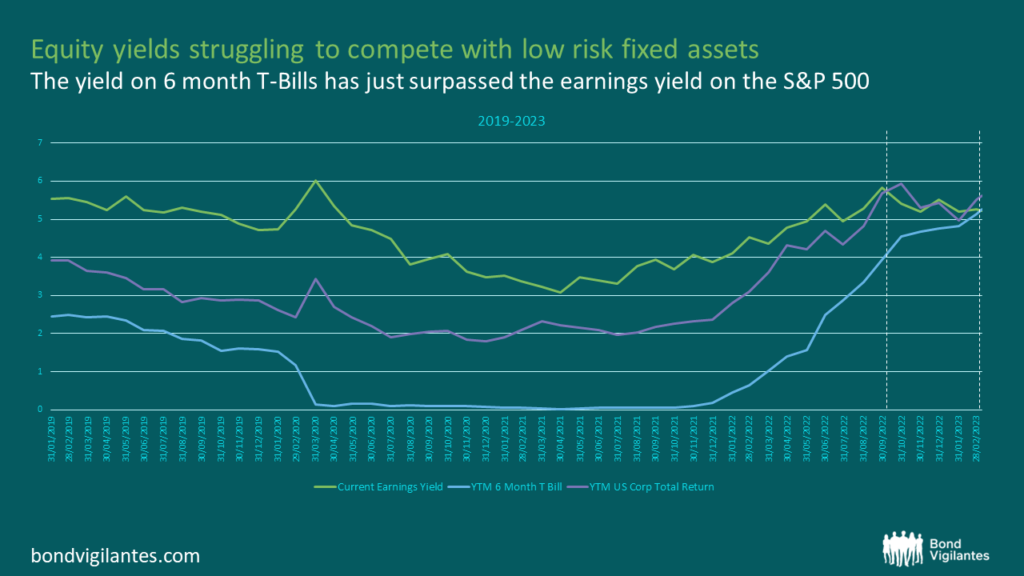The return of the King: Cash makes a comeback
For a long time, it has made no sense to keep money under your mattress or invested in cash-like instruments (short dated, fixed return) such as money market funds, without facing an inflation-adjusted loss. Now, we find ourselves in an environment where aggressive hiking cycles globally have meant deep curve inversions across major markets and short dated yields sky rocketing over the last year. It is now possible to see returns of 5% in the US for virtually risk-free assets, if you assume there is no default risk in the AAA rated sovereign issuer (AA rated from S&P after the debt ceiling was lifted in 2011). This begs the question then, not only does this challenge equity yields, but does it also challenge the long duration trade that would normally prosper in a potential recessionary environment?
Looking at the chart below, last year the big story was that fixed income yields became relatively cheap for the first time in decades. The correlation between fixed assets and equities also broke down, meaning in typical equity/bond portfolios, both government and corporate bonds offered little protection from falling equity markets. In September 2022, all-in yields on 5yr US corporate bonds (investment grade) surpassed the earnings yield on the S&P 500, further pushing the appeal of fixed income. Why would investors take equity risk when they could get paid the same return for a lower risk part of the capital structure? Now however, there’s a new kid in town. At the time of writing, higher deposit rates have caused yields on 6 month T-Bills to also surpass the S&P 500 earnings yield. So why would you now take either credit or equity risk, when money market fixed income instruments that mature in 6 months’ time are now paying you the same? Of course, there is a duration mismatch here. These 6 month instruments would have to be rolled at the same level continuously to make a longer term comparison to equity and corporate bond yields (that are naturally longer duration), but if needing a place to hide in the short term, these levels are hard to ignore.

Now, a key question is – can we assume no default risk in the US? It would be fair to assume that the rise in 6 month yields and the rapid inversion of the US yield curve is not only caused by higher deposit rates and the increased potential for a hard landing, but also by the fact that Washington is once again playing the dangerous game of ‘do we raise the debt ceiling or default on US debt?’ The USD is the global reserve currency and US Treasuries are treated as risk-free assets in the minds of investors, two characteristics that give the US unrivalled financial status in global markets. But ongoing debates over raising the $31.4 trillion debt ceiling perhaps chip away at this, and T-Bills always face the brunt of this debate. If Congress doesn’t address the debt ceiling by summer/autumn, we could see a delayed payment or something similar – not really what you’re looking for in a ‘risk-free’ asset. America’s debt and soaring interest costs have only worsened since S&P’s unprecedented downgrade in 2011, so along with the frequent nature of these political showdowns, the more investors will have to confront volatility at the front end and the (albeit remote) possibility of further downgrades.
Many observers and the ratings agencies expect Washington will get its act together before the scenario of a debt ceiling crisis becomes possible. With this as a base case, a 5% yield for a 6-month T-Bill shows how such money market instruments, along with short dated Treasuries that have also followed the curve inversion (and are not as linked to the debt ceiling story of this year), can offer protection in this volatile rates environment. As it stands, the timing of the long duration trade is still uncertain and highly dependent on both the Fed’s course of action and whether we get a soft/hard landing, or no landing at all.
The value of investments will fluctuate, which will cause prices to fall as well as rise and you may not get back the original amount you invested. Past performance is not a guide to future performance.










